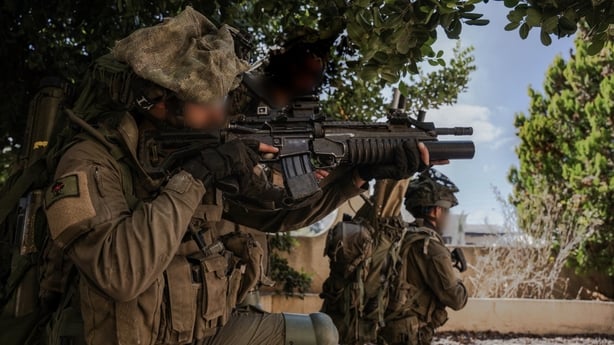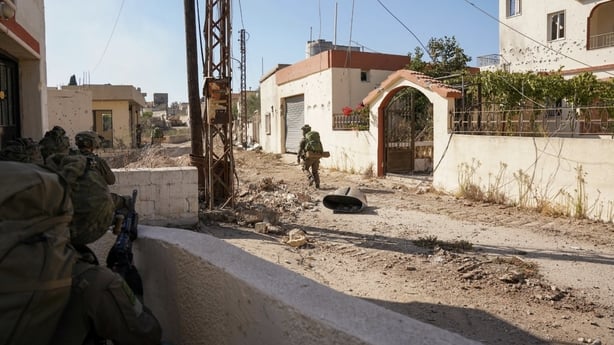The Irish area of operations in southern Lebanon has been at the centre of international diplomatic and military discussions over the last week, after Israel crossed into Lebanon intent on attacking Hezbollah.
The fighting has forced Irish troops - as well as thousands of other UN peacekeepers across the wider UNIFIL zone - into protective bunkers. Hundreds of thousands of civilians had been forced to flee.
The Irish-led UN battalion in Lebanon is responsible for a zone along the de facto border.
There has been much discussion and contested claims about the activity in the area of responsibility, and previous reports on the early days of the Israeli incursion.
Here's what we've been able to establish about the scale of fighting in that area over recent days.
We need your consent to load this Datawrapper contentWe use Datawrapper to manage extra content that can set cookies on your device and collect data about your activity. Please review their details and accept them to load the content.Manage Preferences
An image obtained by RTÉ over the weekend highlighted the proximity of military activity to some Irish troops.
The Irish Defence Forces has requested that the image in question not be published "for reasons of operational security".
It showed the Israeli Defence Forces operating extremely close to UN Post 6-52, where a platoon of around 30 Irish peacekeepers is stationed.
Taken on Saturday, the image showed at least 20 pieces of IDF military equipment, including tanks and armoured vehicles, located at a newly-created Israeli firing position immediately adjacent to the UN post.
There are 29 UN positions based near the blue line - the de facto border between Lebanon and Israel - but activity around 6-52 has been of "critical" concern over the last week, according to the UN mission in Lebanon, known as UNIFIL.
UN Post 6-52 is to the southeast of the town of Maroun El-Ras. The Irish troops stationed in it are attached to a larger base, Camp Shamrock, about 7km away.
From Camp Shamrock, the UN battalion led by Irish officers operates 6-52 and another blue line post, 6-50, which is staffed by troops from a Polish contingent.
Much of the fighting since Israel moved across the blue line seven days ago has centred on the two towns adjacent to the two Irish-overseen outposts, Yaroun and Maroun El Ras.

Hezbollah said yesterday it was attacking IDF troops attempting to advance near Maroun El-Ras, which is on a height overlooking the key town in the area, so is of strategic importance.
6-52 is on the outskirts of Maroun El Ras, in the flat land below the town.
Referencing the UN post in a release, Hezbollah said its fighters had observed the movement of Israeli forces around the location but were ordered not to attack the area to "preserve the lives of the soldiers of the international forces".
It was a welcome statement for many families in Ireland. Despite coming from an organisation few trust in global politics, positive news has been sorely needed.
Weekend clashes
Across the weekend, Hezbollah continued to fire barrages of rockets into Northern Israel, across the blue line, while clashes between Hezbollah fighters and the IDF intensified within the Irish zone. Local media reports, military updates and geolocated footage show fighting has taken the form of rocket fire, airstrikes, ambushes and ground clashes.
On Friday, Arabic-language media reported Israeli strikes in Bint Jbeil had damaged a hospital, midway between Camp Shamrock and Maroun El-Ras.
The IDF said Hezbollah was operating a command centre within a mosque adjacent to the hospital.
In the hours before the strike, the IDF's Arabic-language spokesperson had issued a statement addressing medical workers in Lebanon.
"We have observed the increasing exploitation of rescue vehicles by elements to transport saboteurs and combat equipment," the statement said.
"The IDF warns of the repercussions of the continuation of this phenomenon, calling on medical teams to stay away from Hezbollah elements and not to cooperate with them."
After the strike, doctors working in the hospital told Sky News that the hospital was hit directly, and that it was "categorically untrue" to claim either the mosque or hospital was used by Hezbollah for military purposes.
Later the same day, Hezbollah said it detonated three improvised explosive devices (IED) targeting Israeli forces in the area.
Around the same time, the IDF published images of its troops operating "in southern Lebanon". The published images were geolocated to areas on the eastern edge of Yaroun.

"The troops discovered rocket launcher munitions, anti-tank missiles, and rockets," the IDF statement accompanying the images said.
Fierce fighting would develop in Yaroun over the following days.
On Saturday, Hezbollah said it used a "rocket salvo" to attack "a gathering of Israeli soldiers" near the town.
Arabic-language media then reported Israeli shelling in Yaroun. The towns of Kounine, Hanine were also targeted. Soon after, Hezbollah-affiliated media claimed the group had destroyed an IDF tank "on the outskirts of Maroun El-Ras" using a guided missile.
Hezbolloh positions in Yaroun were the target of sustained fire from the IDF on Sunday. The Al Imam Ali Ibn Taleb Mosque on the southern edge of the town was destroyed in an explosion.
Videos broadcast on Arabic-language television news channels showed the mosque collapsing, followed by smoke plumes rising from the debris.
By yesterday, drone footage had begun circulating online showing the utter destruction of Yaroun. In the footage, many of buildings have been reduced to rubble. The exact date of recording could not immediately be established, but we have geolocated the footage to the eastern side of the town.
The Irish-overseen UN post, 6-50 is on a hill along the blue line, 2km from Yaroun, and has sight-lines onto the west, south and east of the town. UN peacekeepers will have had a view of the fighting, if it was deemed appropriate to take the risk.
כך נראה ההרס בכפר יארון, מול דובב ברעם ויראון, אחרי תקיפות ותמרון של צה"ל pic.twitter.com/wWrlAyHBwk
— איתי בלומנטל 🇮🇱 Itay Blumental (@ItayBlumental) October 7, 2024
The Institute for the Study of War (ISW) monitors military conflicts and issues reports and analysis about on-going battles across the world. It says in southern Lebanon Hezbollah is fighting primarily through ambushes and the use of anti-tank missile fire and IEDs.
The ISW assessment is that Hezbollah has kept the bulk of its forces deep inside Lebanon rather than deploying them to the front in the south.
The IDF says it is targeting military infrastructure in the area, that it has seized dozens of weapons, including anti-tank guided missiles, explosive materials, rockets, and rocket launchers.
It has ordered residents to evacuate southern Lebanon to an area norther of a river, 50,000km away.
A UNIFIL spokesperson told Al Jazeera English "a lot of people have left but a lot of people don't know where to go."
He said the UN’s best estimate is that 150,000 people remain in the UNIFIL zone, which prior to the outbreak of fighting had a population of 500,000. UNIFIL peacekeepers have a mandate to ensure humanitarian access to the region, as well as monitor clashes.
Currently, according to their spokesman, Andrea Tenenti, they are unable to carry out that role.
Yesterday evening, the IDF said it was expanding a military zone on the Israeli side of the blue line. Civilians are now not permitted to enter a large area of Israel across the de facto border from the Irish-monitored section of the blue line.
In a situation update released soon after, the Irish Defence Forces noted the Israeli announcement suggested "an intent to expand operations further."
Referring to the situation around UN Post 6-52, the Irish Defence Forces said "road access has been curtailed due to these military actions, leading to the recommendation that sheltering in place remains the safest option at this time."
It noted fighting between Hezbollah and Israeli had now "shifted north" of the post.
Camp Shamrock is where the majority of Irish troops are stationed. It is 6km north of UN Post 6-52.
Between Camp Shamrock and Maroun El-Ras is the largest town in the area, Bint Jbeil.
It was the site of one of the biggest battles of the 2006 Israel-Hezbollah war.

